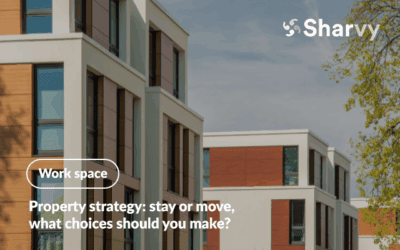Although it’s not a new phenomenon, but intrinsic to our work, thinking about what must be done to create a stimulating working environment has taken on new impetus in recent years.
The notion of well-being in the workplace is now ubiquitous, and few companies ignore it. According to the 2nd M2DG Barometer (2023), conducted in collaboration with YouGov, 87% of employees today expect to work in a pleasant environment with a healthy atmosphere.
Moreover, companies are making well-being and Quality of Life and Working Conditions (QWL) levers for performance, improving the employer brand, and attracting and retaining talent.
That’s why improving the working environment is not something that companies should neglect. All the more so as the issues at stake go well beyond the real estate sphere to encompass HR issues. But how do you go about it? Let’s take a look at 10 golden rules for improving it!
Work environment : what does this mean?
The work environment refers to all the material and human elements that are likely to influence employees in their daily tasks.
As such, it encompasses a range of elements, such as :
- The layout of the workplace : furniture, equipment, workspaces, lighting, temperature, decoration, the presence of a room dedicated to breaks and meals, the possibility of isolating oneself if necessary, etc.
- Human relations : communication and understanding with managers, team atmosphere, internal tensions, conflicts, etc.
- Company culture : type of management, benefits, and services offered to employees (cafeteria, gym, games room), pressure, work-life balance, etc.
- Health and safety conditions : sufficient sanitary facilities, clean and healthy premises, etc.
A healthy working environment encourages employee commitment and boosts productivity tenfold. Their expectations in these terms are significant, especially as they spend most of their time in the workplace.
That’s why the work environment can hinder your employees’ total development if it’s toxic and inadequate.
How can you improve your employees’ working environment? 10 golden rules!
1. Make an excellent 1st impression.
When we meet someone new, we often emphasize the first impression : the first handshake and the first smile, which may (or not) encourage the conversation.
The same applies when your recruit discovers your company’s offices for the first time! They will observe the working environment and the decor and appreciate whether the spaces are open, bright, and welcoming rather than austere and dark. So, from the first few minutes in your offices, she’ll already have a first impression of your working environment and whether it’s inspiring, safe, and pleasant.
Moreover, if you give her a warm welcome rather than a messy one, she’ll remember it. That’s why you should take the time to show them around your premises, introduce them to the different members of the team and give them an overview of current projects.
This approach allows the newcomer to feel immediately included and, conversely, to avoid giving the impression that your working environment is unfriendly. This will inevitably put off many of your recruits from day one.
2. Do not neglect the power of color & light.
Did you know that colors influence our perception, emotions, and behavior?
For example, cool colors such as blue, green, and violet are calming and encourage creativity, while bright colors such as red and yellow are stimulating and improve concentration.
Generally speaking, productivity is higher in offices with colored walls than in white ones. On the other hand, avoid dark colors, such as black and dark blue, as they have a hypnotic effect!
However, in the office, the choice of colors depends, above all, on your employees’ work. If they are regularly under pressure and doing stressful work, choose cool colors to relax them. If, on the other hand, their daily tasks are monotonous, stimulate them with bright colors!
As well as colors, lighting is just as important. Choose natural light wherever possible. For artificial light, opt for warm light and ensure each desk has its lamp.
3. Create workspaces that promote well-being and productivity.
At a time when partitions are coming down to make way for large open spaces with no designated workstations, the question of privacy is looming large. We suggest creating various informal spaces to work in synergy with new working methods (flex office, desk sharing, hot desking, desk booking, zone booking, etc.) while respecting everyone’s individuality.
For example, create enclaves for reflection and individual work. In this way, you recognize everyone’s need for balance. Remember that many employees may find concentrating difficult because of constant background noise, telephone conversations, discussions between colleagues, etc. It is, therefore, essential to have a few individual spaces where they can isolate themselves when they need to concentrate more to complete a task.
At the same time, remember that workplace design counts for much more than you imagine. A modern design should combine comfort and style. Above all, it should be organized according to the “Activity Based Working“. In other words, each area of your company should be designed to respond to a given activity. There’s no need for major works; it’s more a question of optimizing and fitting varied, evolving, and modular spaces.
For example, in addition to open spaces & individual workstations, can be set up in various ways :
- Meeting boxes & huddle rooms : meeting boxes are spaces for 2 to 4 people for interviews, one-to-ones, etc. Huddle rooms are large, confidential meeting rooms for various company projects.
- Project tables, informal and relaxation areas : companies often have tables scattered around open spaces for mobile employees. But other areas are scattered around with sofas, tables, and armchairs for various discussions. There are also cafeterias, games rooms, and/or break rooms.
- Corpoworking spaces : flexible, collaborative workspaces, similar to coworking, but on your company’s premises. It’s like a third place where employees of the same company from different departments and different sites work together. But also people from outside the company, such as service providers, freelancers, etc.
- Spaces without chairs : yes, it’s not easy to sit down all day, and it’s even one of the causes of many problems (backache, stiff hips, neck pain, etc.), especially if your employees have poor posture! That’s why offering them the opportunity to work standing up is important, with high tables scattered around your open spaces. But it’s also important to provide them with footstools and Bloons (ergonomic ball chairs), which allow the abdominal and back muscles to work harder and keep your staff in better shape.
What’s more, the creation of these various spaces not only enables you to meet the needs and expectations of sedentary and ultra-mobile employees who regularly change workspace during the day. But also to break the monotony, they may feel during their working hours.
4. Ensure acoustic comfort in the work environment.
Noise is to sound what weeds are to gardens. Moreover, remember that employees perceive noise pollution as unpleasant, annoying, a source of loss of concentration, and deteriorates relations and the quality of work.
From an economic point of view, and according to a study by ADEME and the Conseil National du Bruit (CNB), the fatigue and lack of concentration caused by a noisy environment are reflected in losses of productivity at work, which represents a loss of earnings for companies of 15.9 billion euros.
So, to avoid this loss of efficiency, increased absenteeism, and the resulting consequences for your teams’ health, consider insulating the interior of your premises (floors, walls, and ceilings), installing acoustic walls and mobile panels, and, as mentioned above, installing individual soundproof enclaves.
Finally, make sure you get the layout of your offices right. For example, avoid placing individual workstations near areas where people interact (entrance, coffee machines, etc.). Similarly, ensure that your meeting rooms are sufficiently isolated from the workstations of employees who are not participating in brainstorming.
5. Bring the air of biophilia.
Vegetation offers a sense of calm and serenity. That’s why we recommend incorporating natural elements into your working environment.
Whether that means plants, plant walls, and/or a pond, there’s no doubt about it : all day behind the screen, bringing the outdoors indoors will increase the productivity and attractiveness of your working environment!
But that’s not all : plants improve air quality, regulate humidity levels, absorb noise, and reduce pollutants. A must for the modern workplace.
Oh yes… Remember to choose low-maintenance plants that can cope with absences at weekends and during the holidays.
6. Cultivate a healthy & participative corporate culture.
There’s no doubt about it : your company’s internal workings significantly impact your working environment. That’s why you need to ensure that you maintain an excellent corporate culture over the long term. And above all, work on it constantly!
Your corporate culture should be an amalgam of your corporate values, management, communication methods, internal operations, and corporate structure.
Very often, an open corporate culture wins the day. So encourage a culture of feedback: both negative (but always with empathy) and positive! Managers must learn to thank their teams, show them genuine recognition, build loyalty, and stimulate motivation.
It should also be noted that this feedback culture assumes that your employees can give feedback to their superiors without fear. The idea is to ensure that everyone can improve but in a humane way!
7. Give more employees access to the company car park.
68%. That’s the number of Britons people who commute to work by car, according to a study “Transport Statistics Great Britain” (February 2018), by the Department for Transport.
However, since parking is the starting point and culmination of any journey, so it is becoming essential for many employees. It plays a (major) part in improving their daily lives and working environment.
All the more so as parking in city centers is becoming increasingly complex. Without a company car park, employees’ vehicles are often left unattended on the roads, at risk of being damaged by malicious individuals. Additionally, your employees waste an average of half an hour every week looking for a parking space.
So, far from being a secondary concern, your company car park’s dynamic and intelligent management is central to the QWL.
In most companies today, parking spaces are (still) allocated on a hierarchical basis, according to seniority, or on a “first come, first served” basis, which is even more restrictive.
As a result, the car park is entire, even if it isn’t, as many spaces still need to be occupied. These spaces, often reserved for employees, cannot be used by other employees, leading to frustration, irritation, and internal conflict if this happens again.
Sharvy is THE solution to this problem, and above all, to double the parking capacity of your car park. It’s a web & mobile application that manages your employees’ arrival on site, allows reservations and allocates spaces to them using a fair algorithm, provides access to site maps, and can even plan access by automating the recognition of a parking space for example.
Your employees’ arrival on-site is made more accessible and more efficient in just a few clicks!
8. Promote open & transparent communication.
Open and transparent communication is essential to improve your work environment over the long term. Encourage your staff to share their ideas, concerns, and suggestions.
Organize regular team meetings to encourage discussion and collaboration. At the same time, use communication tools such as instant messaging platforms to facilitate communication between team members.
At the same time, think about organizing team-building events, but also events outside the office to create and strengthen links and communication between the members of your teams. This way, everyone will get to know each other better and work better together.
9. Offer cutting-edge technology.
Did you know? More than 40% of employees said they had left a company because they couldn’t access the latest digital tools (Randstad study).
As a result, workplaces are changing at a breathtaking pace, and technology has become an inseparable part of any modern working environment.
Today, there is no doubt about it : the availability of technology is directly linked to innovation, creativity, and efficiency at work. It is essential for the personal and professional development of your employees.
That’s why the smart office has been gaining ground in recent years. This is a working environment in which new technologies are used to serve the needs and well-being of employees. The aim is to enable employees to work at their best and improve their productivity. The smart office, therefore, includes, for example :
- Various equipment & IoT technologies : such as smart, connected meeting rooms with cameras and “click and play” technology, videoconferencing software and tools (Zoom, Teams, Google Meet), digital voice assistants, intranet tools, and internal social networks, etc.
- Intuitive web & mobile applications : making it easier to keep track of everyone’s diaries & reserve spaces (parking spaces, workstations, charging points, other resources, etc.). Depending on the application chosen, it is also possible to monitor the occupancy rate of each space and the use of resources.
- Artificial intelligence & process automation software : mainly to improve the operational efficiency of your staff.
By designing and/or improving your working environment, your employees can save precious time and devote energy to higher value-added tasks.
10. Offer a sustainable workplace.
A sustainable workplace is as much about the employee experience as it is about respecting the environment. What’s more, a sustainable interior design offers many benefits for the well-being of employees and is, of course, healthier for them.
So think about incorporating automatic control of heating and lighting, ventilation, and/or air conditioning into your premises, based not only on the data collected but also on the occupancy rate of your spaces (in other words, the desk sharing rate). In this way, not only can you optimize the energy performance of your building and/or premises, but you can also make significant savings.
At the same time, by correctly analyzing factors such as temperature, air quality, light intensity, and noise levels (to name but a few), you can avoid a lot of sick leave. These factors play a significant role in your employees’ moods and directly influence their ability to concentrate and perform tasks.
In conclusion
Taking into account recent changes in work modes, notably the rise of telecommuting and the increasing demand for collaborative and flexible workspaces, it becomes crucial for companies to adapt their office spaces.
This article shows that a positive, dynamic and stimulating work environment encourages your employees to be committed and invested. They are driven by a desire to do well and to surpass themselves, they take up your company’s cause, they associate themselves with its values, and, as a result, they perform much better!
On the other hand, a toxic working environment will have a catastrophic impact on the morale and effectiveness of your staff. What’s more, it can considerably increase absenteeism and staff turnover.
That’s why improving your working environment should be kept from second place, as it has a (significant) impact on the quality of life and well-being of your employees. Following these 10 golden rules should help you to keep your staff happy.
Have a question ? Check out the FAQ !
Why should you strive to create a healthy and caring working environment for your employees?
The benefits of such an approach are well established, but let’s mention a few. On the one hand, you make your teams more productive by providing them with a variety of spaces conducive to concentration and collaboration when necessary.
On the other hand, you reduce absenteeism since a (healthier) and more positive working environment triggers fewer sick days (particularly those linked to burn-out).
At the same time, you’ll increase your employees’ loyalty to your company. After all, there’s no reason for them to leave a company where they feel good and where the employer is taking various steps to improve the quality of life at work.
Last but not least, you’ll be promoting your employer brand. Your employees are satisfied with their working environment and are discussing it with others. This, of course, will attract recruits who the excellent working conditions will attract.
How important is fairness in the working environment?
Fairness is an integral part of a healthy and positive working environment. In practice, however, it is challenging to guarantee within companies because human beings are (unfortunately) full of prejudices, often unconscious.
Age-related prejudices, myths, and stereotypes are just one example of the prejudices that permeate today’s workplace. To overcome these potential blind spots and ensure that your working environment is always – or almost always – pleasant, consider training and ongoing education for your employees to help them recognize their unfair and exclusive behavior.
At the same time, take the time to measure and highlight the opinions of your employees in the workplace. Finally, tackle policies, processes, and practices that prevent fairness, such as allowing new parents to work flexible hours but not other employees with family commitments. Similarly, equity can be found in having access to the company car park.
Sharvy can help you with this, so don’t hesitate to book a demonstration to learn more about the solution!
Want to learn more? Check out latest articles!
Property strategy: stay or move, what choices should your company make?
Should you stay or move? For many companies, this question is now a key part of their property strategy : find the answers here!
Hybrid work space : 5 common misconceptions!
Companies: discover 5 misconceptions about hybrid work space, and our tips for making it a sustainable model!
Office booking : the challenges facing large companies!
Office booking : what challenges do large companies face and how does desk booking help them overcome them?
Subscribe to our newsletter!
PARKING & WORKPLACE MANAGEMENT SOLUTION
Car park management - Charging points monitoring - Desk booking - Booking by time slots
SUBSCRIBE TO THE NEWSLETTER
Receive the latest Parking & Workplace trends by email once a month.












